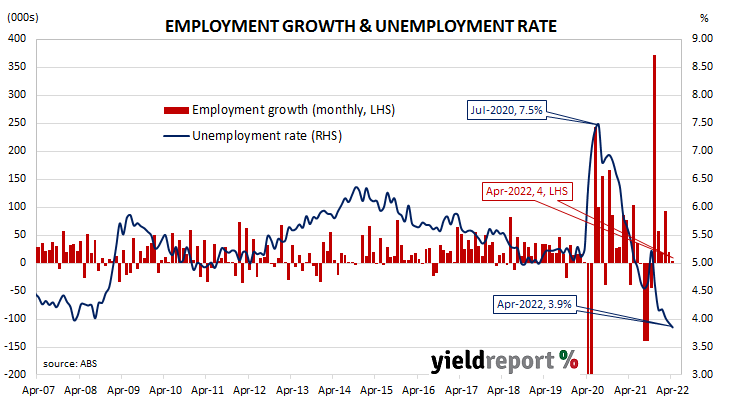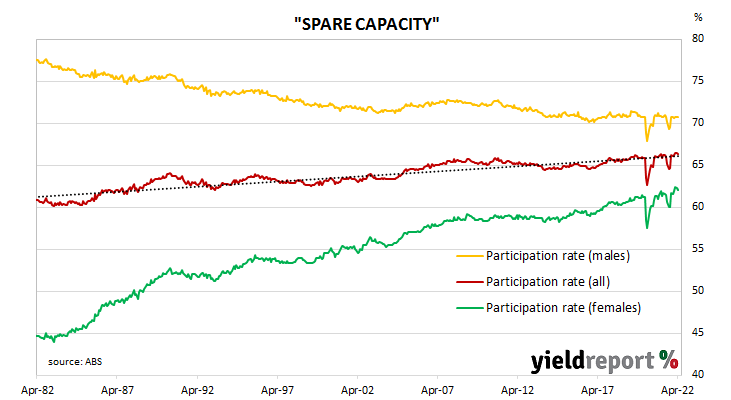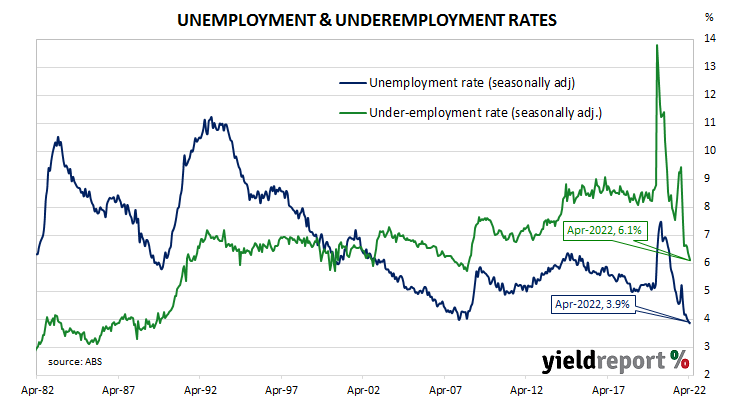Summary: Employment up just 4,000 in April, less than expected; unemployment rate at lowest since 1974; participation rate slips from 66.4% to 66.3%; jobless rate steady at 3.9% after revisions; fewer part-time, more full-time jobs; aggregate work hours up 1.3%; large number of part-time workers shifting to full-time classification; underemployment rate down from 6.3% to 6.1%.
Australia’s period of falling unemployment came to an end in early 2019 when the jobless rate hit a low of 4.9%. It then averaged around 5.2% through to March 2020, bouncing around in a range from 5.1% to 5.3%. Leading indicators such as ANZ’s Job Ads survey and NAB’s capacity utilisation estimate suggested the unemployment rate would rise in the June 2020 quarter and it did so, sharply. The jobless rate peaked in July 2020 but fell below 7% a month later and has since trended lower.
The latest Labour force figures have now been released and they indicate the number of people employed in Australia according to ABS definitions increased by just 4,000 in April. The rise was less than the 30,000 increase which had been generally expected as well as March’s 20,300 increase.
“Although employment growth disappointed, the data is still consistent with a tight labour market and the unemployment rate is the lowest it has been since 1974,” said NAB economist Taylor Nugent.
Domestic Treasury bond yields fell on the day, generally following the movements of US Treasury bond yields in overnight trading. By the close of business, the 3-year ACGB yield had shed 6bps to 2.96%, the 10-year yield had shed 8bps to 3.41% while the 20-year yield finished 9bps lower at 3.74%.
In the cash futures market, expectations of the actual cash rate’s path over time softened. At the end of the day, contract prices implied the cash rate, currently at 0.31%, would rise to 0.55% in June and then rise to 1.335% by August. May 2023 contracts implied a cash rate of 3.29%, 298bps above the current cash rate.
The participation rate slipped to 66.3% from March’s revised figure of 66.4% as the total available workforce decreased by 6,900 to 13.939 million. However, the number of unemployed persons also decreased by 10,900 to 537,100. As a result, the unemployment rate remained steady at 3.9% after revisions as the lower jobless number was offset by a smaller number of people in the workforce.
The aggregate number of work hours across the Australian economy increased as 88,400 residents lost part-time positions and 92,300 residents gained full-time positions. In percentage terms, the total number of work hours rose by 1.3% after declining by 0.3% in March. On a 12-month basis and after revisions, aggregate hours worked increased by 2.8% as 83,700 fewer people held part-time positions and 465,300 more people held full-time positions than in April 2021.
“Don’t assume that some 88,000 part-time employees were sacked and 92,100 full-time employees gained jobs; a lot of this would be due to changes in hours worked and a large number of part-time workers working longer hours thus shifting from a part-time to a full-time classification,” said Westpac senior economist Justin Smirk.
In recent years, more attention has been paid to the underemployment rate, which is the number of people in work but who wish to work more hours than they do currently. April’s underemployment rate fell from 6.3% to 6.1%.
The underutilisation rate, that is the sum of the underemployment rate and the unemployment rate, has a strong correlation with the annual growth rate of the ABS private sector wage index when advanced by one quarter. April’s underutilisation rate of 10.0% corresponds with an annual growth rate of about 4.4%.




